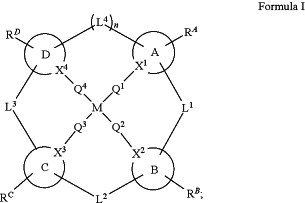| CPC C07F 15/0086 (2013.01) [C07F 15/006 (2013.01); H10K 85/322 (2023.02); H10K 85/346 (2023.02); H10K 85/40 (2023.02); H10K 85/654 (2023.02); H10K 85/6572 (2023.02); H10K 85/6574 (2023.02); H10K 85/6576 (2023.02)] | 20 Claims |
|
1. A compound having a tetradentate structure of
 wherein,
M is Pt or Pd;
rings A, B, C, and D each independently represents a monocyclic or multicyclic fused ring system comprising one or more 5-membered or 6-membered carbocyclic or heterocyclic rings;
RA, RB, RC, and RD each independently represents mono to a maximum possible allowed number of substitution, or no substitution;
each L1, L2, and L3 is independently selected from the group consisting of a direct bond, BR, NR, PR, O, S, Se, C═O, S═O, SO2, CR′R″, SiR′R″, GeR′R″, alkylene, cycloalkylene, arylene, heteroarylene, and combinations thereof;
n is 0 and L4 is not present;
each of RA, RB, RC, RD, R, R′, and R″ is independently a hydrogen or a substituent selected from the group consisting of deuterium, halogen, alkyl, cycloalkyl, heteroalkyl, heterocycloalkyl, arylalkyl, alkoxy, aryloxy, amino, silyl, boryl, alkenyl, cycloalkenyl, heteroalkenyl, alkynyl, aryl, heteroaryl, acyl, carboxylic acid, ether, ester, nitrile, isonitrile, sulfanyl, sulfinyl, sulfonyl, phosphino, and combinations thereof;
any adjacent RA, RB, RC, RD, R, and R′ can be joined to form a ring;
each of X1, X2, X3 and X4 is independently selected from the group consisting of carbon and nitrogen;
each of Q1, Q2, Q3, and Q4 is independently selected from the group consisting of a direct bond, O, and S;
at least two of Q1, Q2, Q3, and Q4 are direct bonds;
at least one of L1, L2, and L3 is selected from the group consisting of BR, NR, PR, CR′R″, SiR′R″, GeR′R″, and combinations thereof;
at least one R when R is present or the combination of R′ and R″ when R′ and R″ are present, comprises at least three 6-membered aromatic rings that are not fused next to each other; and
if one of the rings A, B, C, or D is imidazole and the respective X1, X2, X3, or X4 of said imidazole is nitrogen, the other of rings A, B, C, or D to which said imidazole bonds via L1 or L3 is benzene.
|